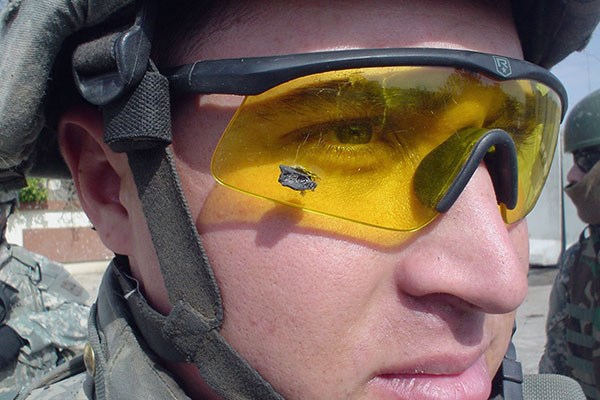Combining Sapphire Glass with Polycarbonate Strengthens Eyewear, Face Shields

09/01/2023
By Katharine Webster
Soldiers have options when it comes to protecting their eyes from flying debris and small projectiles. Multiple manufacturers make protective glasses, prescription eyewear, goggles and face shields that meet Army specifications.
Right now, most Army-approved eyewear and face shields are made of polycarbonate, a clear plastic that is lightweight, flexible and able to absorb low-velocity impacts without shattering.

Polycarbonate has some disadvantages, though, says Mechanical Engineering Assoc. Prof. Alireza Amirkhizi—it scratches easily, develops microcracks that affect transparency and can degrade when exposed to harsh environmental conditions or chemicals. Polycarbonate does not offer complete protection against the most serious ballistic threats soldiers face in modern warfare, such as bullets fired from high-powered rifles or shrapnel from IEDs.
Sapphire has qualities that polycarbonate lacks, and vice versa, Amirkhizi says. Transparent sapphire glass, manufactured industrially from aluminum oxide, is very hard, and it is increasingly used in the aerospace and defense industries—for example, to protect the optical targeting system on the F-35 Joint Strike Fighter.
For that reason, Amirkhizi and Plastics Engineering Asst. Prof. Davide Masato are researching how best to combine polycarbonate and sapphire to make better protective eyewear and face shields. They are working with Milford, New Hampshire-based Luxium Solutions (until recently the crystals division of French manufacturer Saint-Gobain), which has developed a process for “growing” and polishing curved panels of sapphire glass.
“Sapphire is the second-hardest material, after diamond. The problem with sapphire alone is that it is heavy and brittle, and when it shatters, it could become dangerous,” Amirkhizi says. “We want to take the hardness, scratch resistance and durability of sapphire and combine it with polycarbonate, which is light and bends a lot before it breaks.”
“We want to take the hardness, scratch resistance and durability of sapphire and combine it with polycarbonate, which is light and bends a lot before it breaks.” -Assoc. Prof. Alireza Amirkhizi
The project, funded through Harnessing Emerging Research Opportunities to Empower Soldiers (HEROES) and now in its sixth year, is looking at lamination of the two materials, with the sapphire on the outside to protect against impact and the polycarbonate on the inside to protect soldiers against injury from sapphire fragments.
Using curved sapphire glass lenses made by Luxium, the team has combined different thicknesses of each material and experimented with different adhesives, temperatures and pressures for lamination.
They evaluate each laminated sample for various properties, including optical clarity and visual distortion. Finally, they test the samples for durability and breakage patterns by firing .15-caliber and .22-caliber hardened steel projectiles at them, using a helium-powered gas gun.
The optimal laminate has proven to be more protective than either material alone, while remaining lightweight, Amirkhizi says.
“If you sandwich the two together, you get the best of both worlds. The sapphire, even if it breaks, won’t fly into your face,” he says. “And on a gram-to-gram basis, this laminate would deflect and absorb more kinetic energy from a projectile than either material by itself.”
Now that the concept has been verified, the focus has moved to manufacturing. Masato and plastics engineering Ph.D. student Matt Drew ’21, ’23 are refining the injection-molding process for the polycarbonate layer and optimizing the lamination process.
“The goal with lamination is to achieve strong adhesion while preserving the optical characteristics,” Masato says.
Drew is also researching whether other polymers might work better, in combination with sapphire glass, than polycarbonate. “There are some polymers that are just as effective as polycarbonate and have better optical properties,” he says.
Alex Krueger ’18, now in the final year of his Ph.D. in mechanical engineering, led the construction of the helium gas gun used to test not only sapphire and polycarbonate laminates, but also other polymers he is researching with Amirkhizi. He is working on upgrading the gas gun so it can fire projectiles even faster, at or above the speed of sound in air (which is 343 meters per second).
Postdoctoral researcher Saurabh Dixit, also in Amirkhizi’s lab, is creating computer simulations of the material characterization tests.

“Experiments cost a lot, and if you can replicate them on a computer, it can save a lot of resources,” Dixit says. “So, I do the physical test on the sapphire and I try to replicate it on the computer. Now that I understand the sapphire’s characteristics, and once I know that the simulation is correct, then I can use the computer to see what would happen if the material was of a different thickness or shape.”
All three say that working across disciplines on the project has enhanced their learning. Amirkhizi and Masato agree.
“That part of a multidisciplinary project is very enriching, not only for the faculty and students, but also for sponsors and collaborators like Luxium,” Amirkhizi says.
“HEROES favors interdisciplinary collaboration to support the development of prototypes and commercialization,” Masato says. “We improve and speed up the process by working together.”
